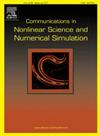基于一类拟正交多项式构造的虚元及其在四阶椭圆问题中的应用
IF 3.4
2区 数学
Q1 MATHEMATICS, APPLIED
Communications in Nonlinear Science and Numerical Simulation
Pub Date : 2025-05-05
DOI:10.1016/j.cnsns.2025.108884
引用次数: 0
摘要
为了改进已有的经典虚元求解四阶椭圆问题,提出了一类特殊的拟正交多项式,并在此基础上构造了一类新的数值积分公式。该公式的特殊之处在于利用了区间端点处的函数值和被积函数的导数值,在虚元构造等场合具有一定的实用性。然后,用上述公式积分点处的函数值代替已有虚元中的边缘积分自由度,提出了求解四阶椭圆问题的修正虚元。分析了改进后的虚元的收敛性和可计算性,结果表明该虚元在保持原有收敛顺序的情况下,具有编程实现更简单、计算复杂度更低的特点。最后给出了数值结果,验证了该单元在求解四阶椭圆型问题时的收敛性。本文章由计算机程序翻译,如有差异,请以英文原文为准。
A virtual element constructed based on a class of quasi-orthogonal polynomials and its application to fourth-order elliptic problems
In order to improve an existing classical virtual element for the fourth-order elliptic problem, we propose a special class of quasi-orthogonal polynomials and then construct a new type of numerical integration formula based on the polynomials. The special feature of the formula is that it uses the function values and the derivative values of the integrand at the endpoint of the interval, which is of some practicality in virtual element construction and other occasions. Then, we replace the edge integral degrees of freedom (DoFs) in the existing virtual element with the function values at the integral points of the above formula, and propose a modified virtual element for solving the fourth-order elliptic problem. We analyze the convergence and computability of the modified virtual element, and the results show that the element has the characteristics of simpler programming implementation and lower computational complexity while maintaining the original convergence order. Finally, numerical results are given to verify the convergence of the element in solving the fourth-order elliptic problem.
求助全文
通过发布文献求助,成功后即可免费获取论文全文。
去求助
来源期刊

Communications in Nonlinear Science and Numerical Simulation
MATHEMATICS, APPLIED-MATHEMATICS, INTERDISCIPLINARY APPLICATIONS
CiteScore
6.80
自引率
7.70%
发文量
378
审稿时长
78 days
期刊介绍:
The journal publishes original research findings on experimental observation, mathematical modeling, theoretical analysis and numerical simulation, for more accurate description, better prediction or novel application, of nonlinear phenomena in science and engineering. It offers a venue for researchers to make rapid exchange of ideas and techniques in nonlinear science and complexity.
The submission of manuscripts with cross-disciplinary approaches in nonlinear science and complexity is particularly encouraged.
Topics of interest:
Nonlinear differential or delay equations, Lie group analysis and asymptotic methods, Discontinuous systems, Fractals, Fractional calculus and dynamics, Nonlinear effects in quantum mechanics, Nonlinear stochastic processes, Experimental nonlinear science, Time-series and signal analysis, Computational methods and simulations in nonlinear science and engineering, Control of dynamical systems, Synchronization, Lyapunov analysis, High-dimensional chaos and turbulence, Chaos in Hamiltonian systems, Integrable systems and solitons, Collective behavior in many-body systems, Biological physics and networks, Nonlinear mechanical systems, Complex systems and complexity.
No length limitation for contributions is set, but only concisely written manuscripts are published. Brief papers are published on the basis of Rapid Communications. Discussions of previously published papers are welcome.
 求助内容:
求助内容: 应助结果提醒方式:
应助结果提醒方式:


